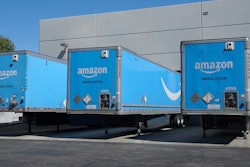 Imports from the West Coast are surging as retail volumes continue to drive the economic recovery. Can manufacturing pick up in time to help sustain momentum? That’s the key question facing freight demand, said Eric Starks, FTR’s president and CEO.
Imports from the West Coast are surging as retail volumes continue to drive the economic recovery. Can manufacturing pick up in time to help sustain momentum? That’s the key question facing freight demand, said Eric Starks, FTR’s president and CEO.Freight volumes should remain sustained through year’s end as Americans continue to spend on retail goods — so far the underpinning of the economy’s, and trucking’s, recovery since the steep downturn in April and May caused by the COVID-19 pandemic and state shutdown orders.
However, some stumbling blocks could lie ahead, especially if retail spending cools after the holiday season.
Those were the key points made by FTR analysts last week in one of FTR’s Engage series of online sessions taking place in lieu of the firm’s annual forecasting conference.
Retail inventories are low, yet retail demand remains high, said Eric Starks, president and chief executive officer for FTR. “That puts pressure on the movement of goods,” he said of ongoing restocking. “We’ve seen huge strength coming into the West Coast ports,” he said — part of that surge in retail volumes.
However, the industrials side of the economy remains somewhat weak, severely lagging the strong rebound in the retail side. “That’s where I would have concern beyond the next couple of months,” said Avery Vise, FTR’s vice president of trucking.
“Structurally, it becomes a question mark,” said Starks, referring to retail carrying the economic recovery. “Can this type of strength continue? I have been one of the more pessimistic people out there,” he said, regarding the pandemic’s impacts on the economy. “I’m waiting for the data to show up and say ‘It’s all good, and we’re back to normal.’ But so far, I haven’t seen that.”
One positive-case scenario would be for manufacturing and industrial goods movement to pick up as retail spending slows, which would keep freight volumes solid. “That would be fantastic,” Starks said. But data so far doesn’t show whether that will be the case.
The spot market, which crashed hard in April and May as freight volumes dried up, has since benefited from the chaos in the supply chain and shifting consumer habits. So while the spot market’s surge in freight and rates isn’t a bad thing, “the spot market is not the freight market” overall, Vise said. “It’s important as an indicator. It’s a good directional indicator of where we’re going. But overall, the freight market clearly has not recovered to the degree the spot market has.” Spot freight typically only accounts for around 10%-15% of all freight movement, he said.
FTR projects overall truck loadings to drop by 6% in 2020 compared to 2019, then climb by 6% in 2021. However, volatility in economic vdata is prompting FTR to update its forecasts monthly.
While capacity is creeping back into the market, some 95,000 or so drivers were cut from trucking’s rolls in the April-May downturn, which is contributing to much of the supply chain’s ongoing instability. Vise said that while capacity easily could contract in under the current labor environment (high unemployment and lots of job seekers), fleet utilization could approach a 10-year high by year’s end should freight demand sustain.
Likewise, the ongoing chaos in the freight market, combined with shippers’ sour experience just two years ago in 2018’s capacity crunch, means shippers increasingly are willing to pay extra to lock-in capacity, Vise said. “More and more shippers are saying ‘I will pay extra for certainty.’ That’s not a mentality that existed for a long, long time.”
Also, more shippers are looking at for-hire fleets as “outsources of private fleets, if you will,” Vise said, and then leaning on burgeoning freight-matching technologies to move loads on the spot market if necessary.












